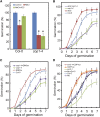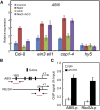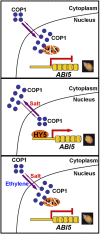Salt Stress and Ethylene Antagonistically Regulate Nucleocytoplasmic Partitioning of COP1 to Control Seed Germination
- PMID: 26850275
- PMCID: PMC4825130
- DOI: 10.1104/pp.15.01724
Salt Stress and Ethylene Antagonistically Regulate Nucleocytoplasmic Partitioning of COP1 to Control Seed Germination
Abstract
Seed germination, a critical stage initiating the life cycle of a plant, is severely affected by salt stress. However, the underlying mechanism of salt inhibition of seed germination (SSG) is unclear. Here, we report that the Arabidopsis (Arabidopsis thaliana) CONSTITUTIVE PHOTOMORPHOGENESIS1 (COP1) counteracts SSG Genetic assays provide evidence that SSG in loss of function of the COP1 mutant was stronger than this in the wild type. A GUS-COP1 fusion was constitutively localized to the nucleus in radicle cells. Salt treatment caused COP1 to be retained in the cytosol, but the addition of ethylene precursor 1-aminocyclopropane-1-carboxylate had the reverse effect on the translocation of COP1 to the nucleus, revealing that ethylene and salt exert opposite regulatory effects on the localization of COP1 in germinating seeds. However, loss of function of the ETHYLENE INSENSITIVE3 (EIN3) mutant impaired the ethylene-mediated rescue of the salt restriction of COP1 to the nucleus. Further research showed that the interaction between COP1 and LONG HYPOCOTYL5 (HY5) had a role in SSG Correspondingly, SSG in loss of function of HY5 was suppressed. Biochemical detection showed that salt promoted the stabilization of HY5, whereas ethylene restricted its accumulation. Furthermore, salt treatment stimulated and ethylene suppressed transcription of ABA INSENSITIVE5 (ABI5), which was directly transcriptionally regulated by HY5. Together, our results reveal that salt stress and ethylene antagonistically regulate nucleocytoplasmic partitioning of COP1, thereby controlling Arabidopsis seed germination via the COP1-mediated down-regulation of HY5 and ABI5. These findings enhance our understanding of the stress response and have great potential for application in agricultural production.
© 2016 American Society of Plant Biologists. All Rights Reserved.
Figures








Similar articles
-
Abscisic acid-induced cytoplasmic translocation of constitutive photomorphogenic 1 enhances reactive oxygen species accumulation through the HY5-ABI5 pathway to modulate seed germination.Plant Cell Environ. 2022 May;45(5):1474-1489. doi: 10.1111/pce.14298. Epub 2022 Mar 10. Plant Cell Environ. 2022. PMID: 35199338 Free PMC article.
-
The hydrogen sulfide signal enhances seed germination tolerance to high temperatures by retaining nuclear COP1 for HY5 degradation.Plant Sci. 2019 Aug;285:34-43. doi: 10.1016/j.plantsci.2019.04.024. Epub 2019 May 1. Plant Sci. 2019. PMID: 31203892
-
The Arabidopsis U-box E3 ubiquitin ligase PUB30 negatively regulates salt tolerance by facilitating BRI1 kinase inhibitor 1 (BKI1) degradation.Plant Cell Environ. 2017 Nov;40(11):2831-2843. doi: 10.1111/pce.13064. Epub 2017 Sep 21. Plant Cell Environ. 2017. PMID: 28865087
-
Seedlings Transduce the Depth and Mechanical Pressure of Covering Soil Using COP1 and Ethylene to Regulate EBF1/EBF2 for Soil Emergence.Curr Biol. 2016 Jan 25;26(2):139-149. doi: 10.1016/j.cub.2015.11.053. Epub 2015 Dec 31. Curr Biol. 2016. PMID: 26748855 Free PMC article. Review.
-
The role of COP1 in repression of Arabidopsis photomorphogenic development.Trends Cell Biol. 1999 Mar;9(3):113-8. doi: 10.1016/s0962-8924(99)01499-3. Trends Cell Biol. 1999. PMID: 10201077 Review.
Cited by
-
Abscisic acid-induced cytoplasmic translocation of constitutive photomorphogenic 1 enhances reactive oxygen species accumulation through the HY5-ABI5 pathway to modulate seed germination.Plant Cell Environ. 2022 May;45(5):1474-1489. doi: 10.1111/pce.14298. Epub 2022 Mar 10. Plant Cell Environ. 2022. PMID: 35199338 Free PMC article.
-
Mulberry EIL3 confers salt and drought tolerances and modulates ethylene biosynthetic gene expression.PeerJ. 2019 Feb 19;7:e6391. doi: 10.7717/peerj.6391. eCollection 2019. PeerJ. 2019. PMID: 30809434 Free PMC article.
-
The apple MdCOP1-interacting protein 1 negatively regulates hypocotyl elongation and anthocyanin biosynthesis.BMC Plant Biol. 2021 Jan 6;21(1):15. doi: 10.1186/s12870-020-02789-3. BMC Plant Biol. 2021. PMID: 33407118 Free PMC article.
-
Molecular Mechanisms of Plant Responses to Salt Stress.Front Plant Sci. 2022 Jun 27;13:934877. doi: 10.3389/fpls.2022.934877. eCollection 2022. Front Plant Sci. 2022. PMID: 35832230 Free PMC article. Review.
-
Interplay between Light and Plant Hormones in the Control of Arabidopsis Seedling Chlorophyll Biosynthesis.Front Plant Sci. 2017 Aug 17;8:1433. doi: 10.3389/fpls.2017.01433. eCollection 2017. Front Plant Sci. 2017. PMID: 28861105 Free PMC article. Review.
References
-
- Achard P, Cheng H, De Grauwe L, Decat J, Schoutteten H, Moritz T, Van Der Straeten D, Peng J, Harberd NP (2006) Integration of plant responses to environmentally activated phytohormonal signals. Science 311: 91–94 - PubMed
-
- Almansouri M, Kinet JM, Lutts S (2001) Effect of salt and osmotic stresses on germination in durum wheat (Triticum durum Desf.). Plant Soil 231: 243–254
-
- Ang LH, Chattopadhyay S, Wei N, Oyama T, Okada K, Batschauer A, Deng XW (1998) Molecular interaction between COP1 and HY5 defines a regulatory switch for light control of Arabidopsis development. Mol Cell 1: 213–222 - PubMed
Publication types
MeSH terms
Substances
LinkOut - more resources
Full Text Sources
Other Literature Sources
Molecular Biology Databases

